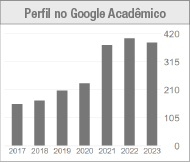Cabaré das Divinas Tetas: cruzamento entre palhaçaria, arte drag e feminismos
DOI:
https://doi.org/10.5965/1414573102472023e0110Palavras-chave:
Palhaças, Circo, Arte drag, Arte feminista, CabaréResumo
Este artigo se propõe a abordar o contexto no qual surgiu a plataforma de criação Divinas Tetas, de Belo Horizonte. Será traçada uma breve análise da trajetória de articulação de mulheres palhaças na capital mineira, nas duas primeiras décadas do século 21, e levantados questionamentos sobre os conceitos de palhaçaria feminina, arte drag, cabaré, gênero e feminismos. Trata-se de um estudo de caso dos caminhos “palhacísticos” e “cabareteiros” que constituem parte da trajetória do movimento da palhaçaria feminina belo-horizontina. Ou (para sermos palhaças mais diretas) quem são as Divinas Tetas, onde vivem, o que comem, como se reproduzem. Como referências teóricas e bibliográficas para este estudo, são citadas(os) as(os) autoras(es) Lili Castro, Daiani Brum, Ana Fuchs, Melissa Caminha, Erminia Silva, Renata Saavedra, Cleber Braga, Judith Butler, Manuela Castelo Branco de Oliveira e Neyde Veneziano.
Downloads
Referências
BRAGA, Cleber. Tra(d)ição como ética decolonial do cabaré sudaca: Cantada em prosa, verso e rebolado!. Urdimento - Revista de Estudos em Artes Cênicas, Florianópolis, v. 2, n. 41, p. 1-31, set. 2021.
BRUM, Daiani Cezimbra Severo Rossini. Mulheres palhaças e a política uterina de expansão: entrevista com Karla Concá. Urdimento - Revista de Estudos em Artes Cênicas, Florianópolis, v. 3, n. 33, p. 455-468, dez. 2018.
BUTLER, Judith. Problemas de gênero. Feminismo e subversão da identidade. Trad. Renato Aguiar. Rio de Janeiro: Civilização Brasileira, 2003.
CAMINHA, Melissa Lima. Jennifer Miller, palhaça com barba: clown_tatos em prol de uma palhaçaria feminista-queer. In: WUO, Ana; BRUM, Daiani (Org.). Palhaças na universidade: pesquisas sobre a palhaçaria feita por mulheres e as práticas feministas em âmbitos acadêmicos, artísticos e sociais. Santa Maria: Editora UFSM, 2022. p. 245-263.
CAMINHA, Melissa Lima. Payasas Historias, Cuerpos y Formas de Representar la Comicidad desde una Perspectiva de Género. 2015. Tese (Doctorado) – Programa de Doctorado: Artes y Educación, Facultad de Bellas Artes, Sección de Pedagogías Culturales, Universidad de Barcelona. Barcelona, 2015.
CARDOSO, Manuela Castelo Branco de Oliveira. “Sapatadas da vida”, ou por uma “ciência gaiata”. In: BRONDANI, Joice Aglae (Org.). Mulher, Mito, Riso e Cena. São Paulo: Giostri, 2020. p. 143-168.
CASTRO, Lili. Palhaços: multiplicidade, performance e hibridismo. Rio de Janeiro: Mórula, 2019.
FUCHS, Ana Carolina Müller. A Palhaça entre as configurações de gênero e a máscara. In: WUO, Ana; BRUM, Daiani (Org.). Palhaças na universidade: pesquisas sobre a palhaçaria feita por mulheres e as práticas feministas em âmbitos acadêmicos, artísticos e sociais. Santa Maria: Editora UFSM, 2022. p. 31-46.
SAAVEDRA, Renata Franco. Mulheres palhaças: a poética e a política da comicidade feminina. Monografia (Graduação em Jornalismo) – Universidade Federal do Rio de Janeiro, Rio de Janeiro, 2011.
SILVA, Erminia. Histórias do aqui e agora: cabaré e a teatralidade circense. Repertório Teatro & Dança, Salvador, ano 13, n. 15, p. 59-73, 2010.
VENEZIANO, Neyde. O Teatro de Revista no Brasil: dramaturgia e convenções. São Paulo: Sesi-SP, 2013.
Sites
Clube da Esquina. Disponível em: https://pt.wikipedia.org/wiki/Clube_da_Esquina . Acesso em: 1 jun. 2022.
Nascemos nus, o resto é drag. Disponível em: https://ipla.com.br/conteudos/artigos/nascemos-nus-o-resto-e-drag/. Acesso em: 27 jan. 2023.
Picadeiro de sonhos: Casa Circo Gamarra acolhe artistas circenses de passagem pela capital. Disponível em: https://www.hojeemdia.com.br/entretenimento/picadeiro-de-sonhos-casa-circo-gamarra-acolhe-artistas-circenses-de-passagem-pela-capital-1.615417. Acesso em: 1 jun. 2022.
RuPaul. Disponível em: https://pt.wikipedia.org/wiki/RuPaul. Acesso em: 29 jan. 2023.
Publicado
Como Citar
Edição
Seção
Licença
Copyright (c) 2023 Urdimento: Revista de Estudos em Artes Cênicas

Este trabalho está licenciado sob uma licença Creative Commons Attribution 4.0 International License.
Declaração de Direito Autoral
Os leitores são livres para transferir, imprimir e utilizar os artigos publicados na Revista, desde que haja sempre menção explícita ao(s) autor (es) e à Urdimentoe que não haja qualquer alteração no trabalho original. Qualquer outro uso dos textos precisa ser aprovado pelo(s) autor (es) e pela Revista. Ao submeter um artigo à Urdimento e tê-lo aprovado os autores concordam em ceder, sem remuneração, os seguintes direitos à Revista: os direitos de primeira publicação e a permissão para que a Revista redistribua esse artigo e seus meta dados aos serviços de indexação e referência que seus editores julguem apropriados.
Este periódico utiliza uma Licença de Atribuição Creative Commons– (CC BY 4.0)




